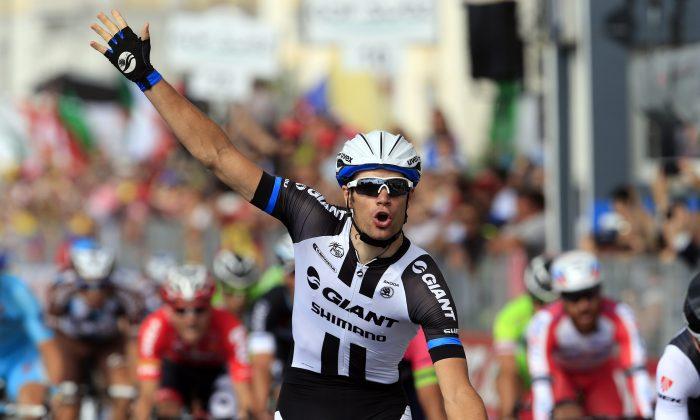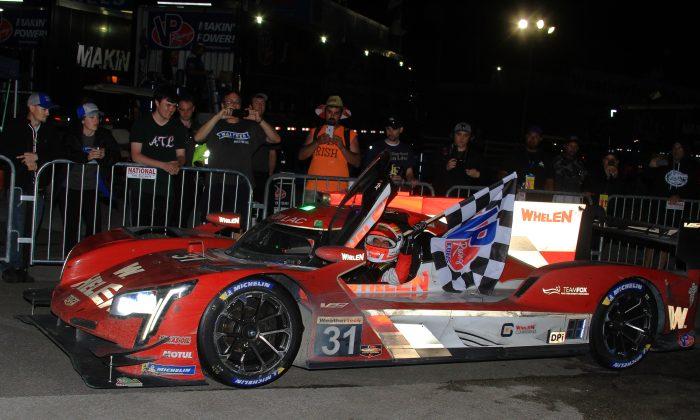Luka Mezgec of Giant-Shimano won a four-rider sprint to win the final stage of the 97th Giro d'Italia Sunday, finally getting a stage victory on the last stage of the race.
The 172 km course from Gemona del Friuli to Trieste wasn’t contested until the race entered the city for eight seven-km laps.
Svein Tuft, first to wear the race leader’s pink jersey, was first to attack, gaining some final exposure for his decimated Orica-GreenEdge team. After wining Stage One and keeping the jersey until Stage Eight, everything unraveled for Orica; illness and injury sent seven riders home. Tuft showed that the squad still had fighting spirit.
Lotto-Belisol’s Lars Bak joined the short-lived attack; this pair was allowed to stay out front until halfway through the third-to-last lap. With 17 km left in the stage, Stefano Pirazzi from the irrepressible Bardiani squad led Astana’s Mikel Landa and Carlos Quintero of Colombia in an attack which caught Tuft and Bak.
The new leading trio had a much shorter lifespan—with two laps to go the peloton got serious and the teams with big sprinters came to the fore, and Pirazzi et al were caught a lap and a-half from the finish.
Sky’s Phillip Deignan led a group of Trek and Cannondale riders at a pace so high no one could escape. Of course riders did: Bardiani’s Francesco Bongiorno (no surprise) and Lotto’s Adam Hansen took shots, but couldn’t make them stick.
The course featured a short climb in the final third of the lap—4.7 percent, with a seven-percent peak. It wasn’t a categorized climb, but it was steep enough to string out the peloton and break up all the leadout trains.
BMC’s Daniel Oss took advantage of the disorganization to attack 2.8 km from the finish,. He got a good gap and looked like he had a chance, but the big sprint teams turned up the pace and caught him just before the flamme rouge.
Cannondale never recovered from the confusion of the last hill climb, but Trek, Giant, and FDJ had enough organization to bring riders up, and others followed.
FDJ lined up on the far left, with Sebastien Chavanel ahead of Lampre’s Roberto Ferrari and Nacer Bouhanni on Ferrari’s wheel. Garmin Sharp’s Tyler was to the right of the FDJ train, following Trek’s Giacomo Nizzolo and Giant’s Luca Mezgec.
Chavanel brought Ferrari to the front, thinking it was Bouhanni on his wheel. Ferrari took off and cut right towards the barriers, but was immediately swamped as Farrar and Mezgec both launched.
Bouhanni followed Farrar; Nizzolo launched just as Farrar started to pass. Bouhanni couldn’t come around Farrar; Farrar couldn’t get by Nizzolo. Nobody could keep up with Mezgec, who blew by on the far right to take the win.
Mezgec had been looking for a stage victory ever since Giant sprinter Marcel Kittel withdrew in Stage Three; it took him until the final few meters of the 3457-km race, but he got that win.
FDJ’s Nacer Bouhanni didn’t get his fourth stage win; he finished fourth, which was still good enough to win him the red Points Classification jersey with 291 points to Nizzolo’s 265.
Giro de Quintana
Nairo Quintana, a 24-year-old Colombian riding for Movistar, showed tremendous form throughout the Giro, and certainly earned his GC win, with victories in two of the toughest stages.
Despite battling some kind of infection through the fists week, Quintana never showed weakness; even on the toughest of the very tough mountain stages he never even showed discomfort, let alone distress. In all likelihood he could have pushed on to take a third stage win on the Zoncolan if he hadn’t been so far ahead in GC already.
He not only destroyed the competition on the climbs, he turned in a decent time trial, tying for 13th only 2:41 down, which is less than it sounds like considering stage winner Rigoberto Uran finished 1:17 quicker than Lampre’s Diego Ulissi in second.
GC contenders have to be excellent in the high mountains, but they need to be able to ride the “Race of Truth;” not a few Grands Tours have been one with solo rides. Quintana has some ground to gain here, but he is already more than competent on a TT bike.
The young Colombian profited by having a healthy team around him—Movistar was one of two teams which brought all their riders home. Even so, when it came down to it, Quintana was able to hold his lead through personal ability; when the race was head-to-head, the tiny Colombian was a head above the rest.
Colombia Climbs to the Top of Cycling
While the first half of the 97th Giro d'Italia was all about Australia, with Orica-GreenEdge holding the maglia rosa before handing it off to BMC’s Aussie team leader Cadel Evans, the second half of the Giro was all about the Colombians.
Rigoberto Uran took the jersey from Evans, then lost it to Nairo Quintana but held on to second place.
Quintana won two stages, Best Young Rider, and topped it all off by winning the General Classification as well.
Another Colombian, Trek’s Julian Arredondo, won the King of the Mountain jersey by 41 points, 173 to Dario Cataldo’s 132. Quintana came third in the classification with 88, and two more Colombians, Edoardo Chalapud and Jarlinson Pantano, made the top ten, with Fabio Duarte coming in eleventh.
Young riders also featured prominently in its year’s Giro.
Quintana, at 24, has a at least a decade of strong racing ahead of him; Astana’s Fabio Aru, who finished third overall and second in Young Rider, is only 22—he will be challenging Quintana for overall wins for quite a while.
Sixth overall and third in Young Rider was Tinkoff-Saxo’s Rafal Majka, also, 24, who will be challenging with the other two for the foreseeable future.
Seventh overall and fourth in Best Young Rider was Belkin’s Wilco Kelderman, one more who will be challenging for GC wins for many years to come. None of these riders have reached their full strengths yet—it could be a few years before they show their full potential.
Finally, fifth in Young Rider and 22 in GC was Sebastien Henao, a 20-year-old Colombian who could be the next Nairo Quintana in a few years—when Nairo Quintana has replaced Bradley Wiggins, Chris Froome, and Alberto Contador at the sharp end of the GC fight.






Friends Read Free